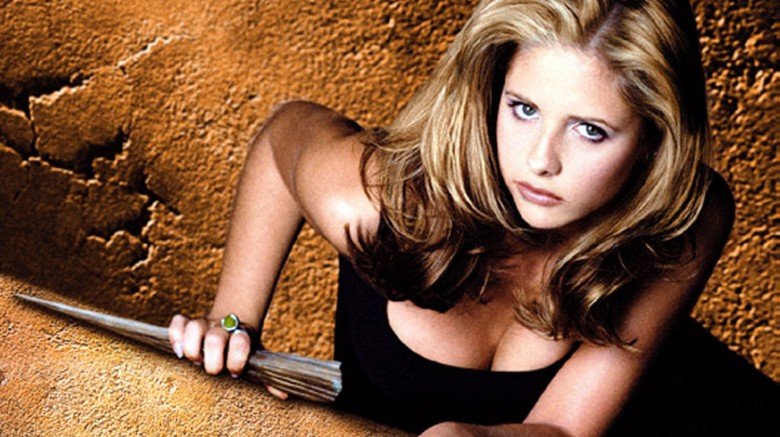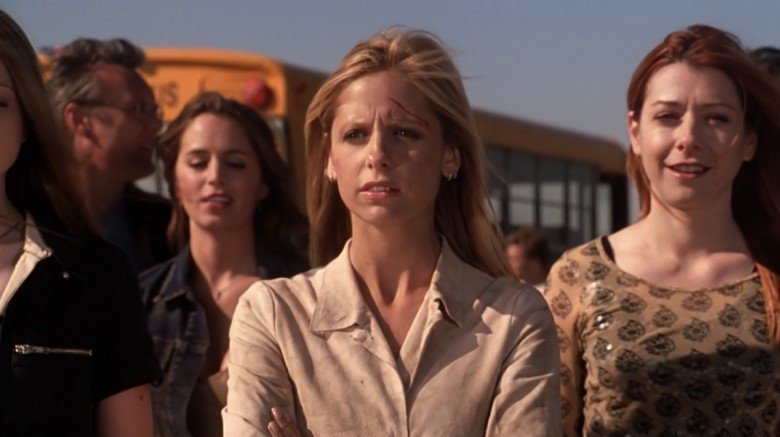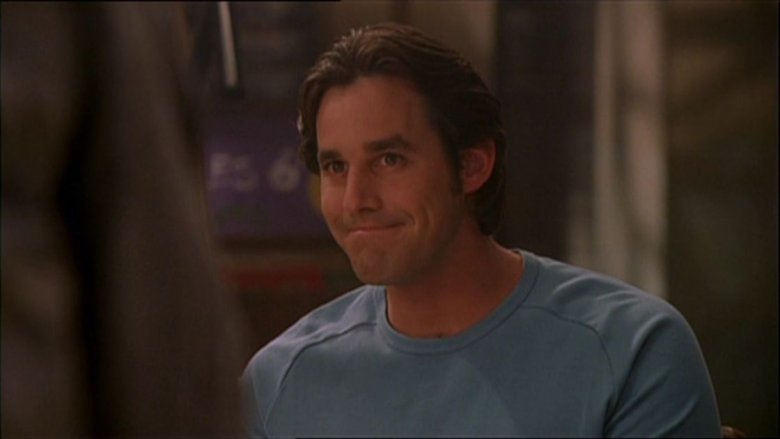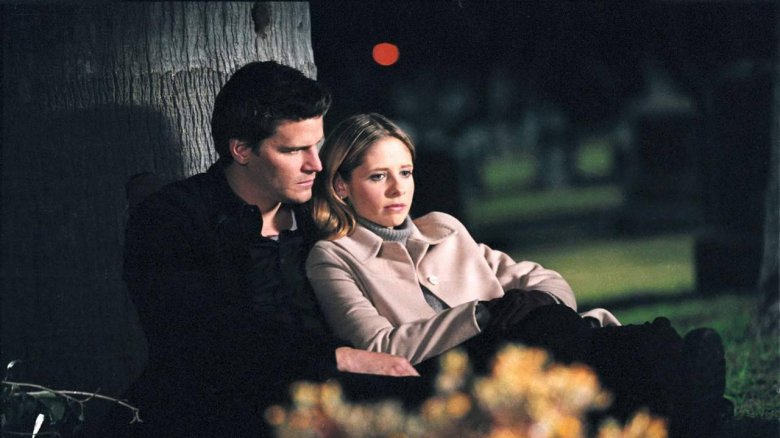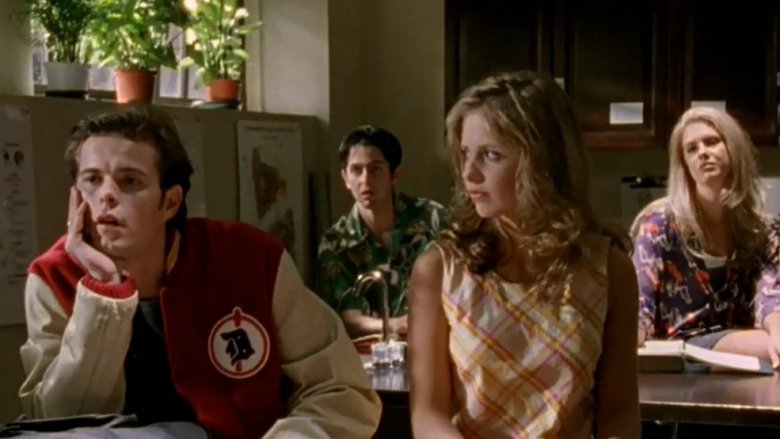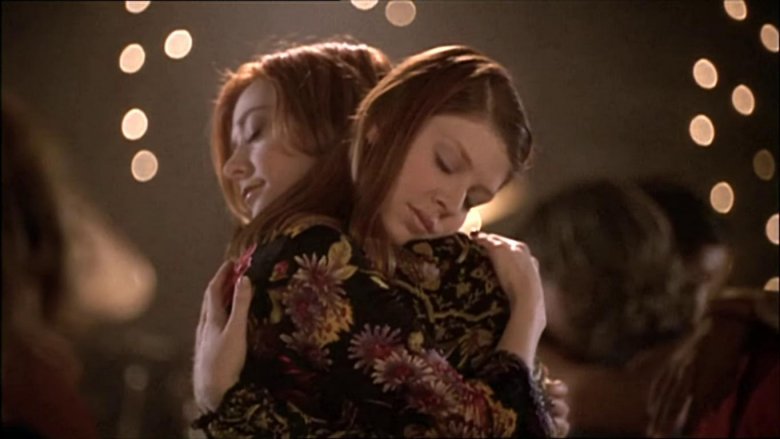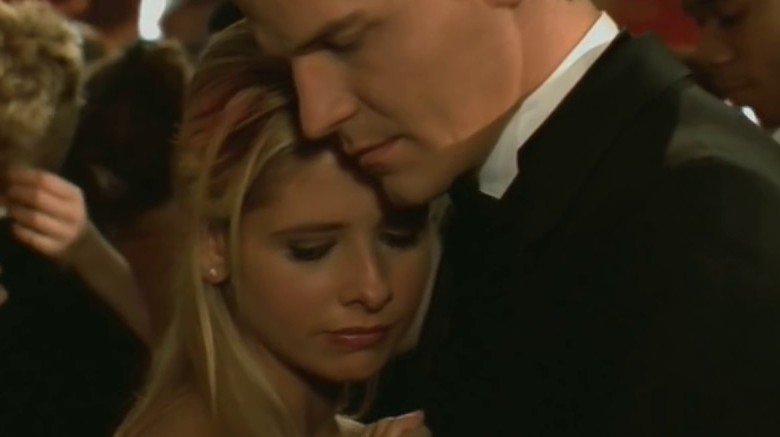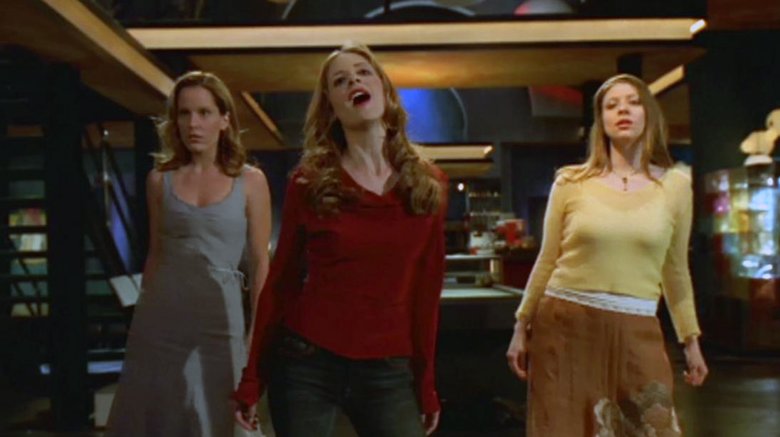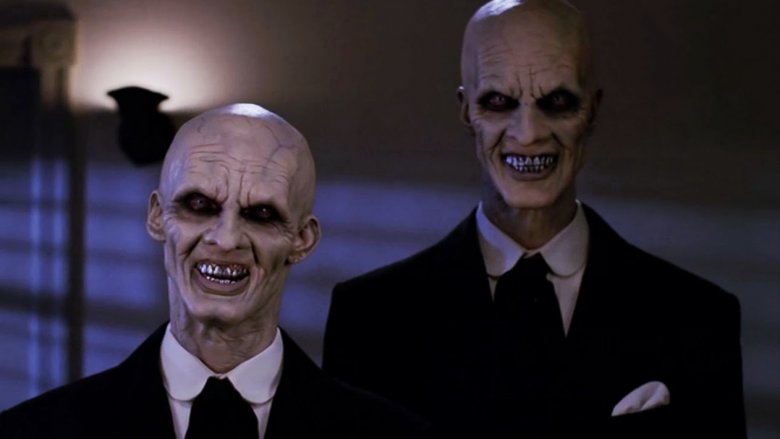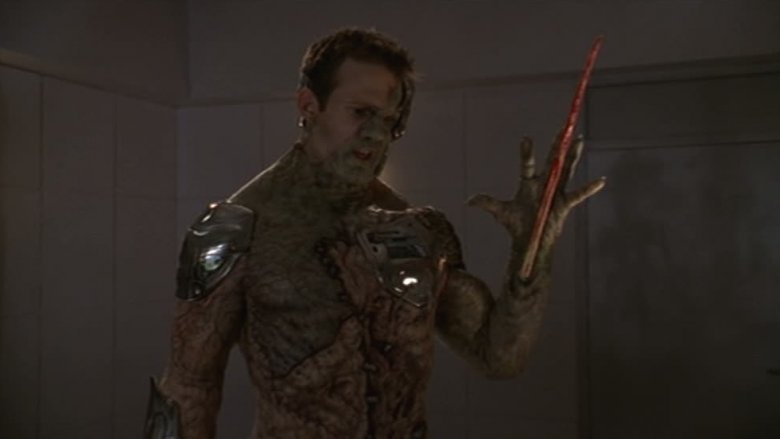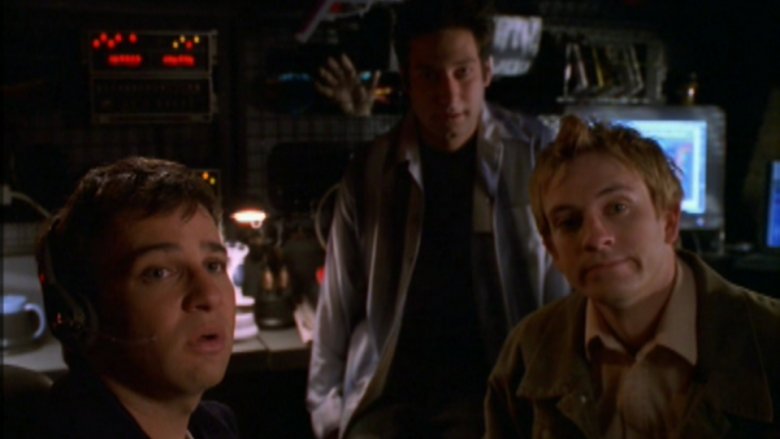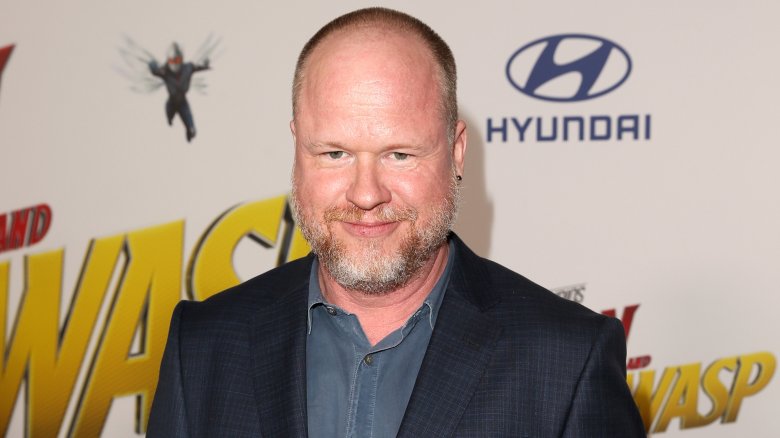How Buffy The Vampire Slayer Changed TV And No One Noticed
Sometimes a show is so singular in its approach and leaves such a unique imprint on the culture's collective memory that despite its success, appeal, and influence, it proves difficult to see exactly how it's changed things. It proves so distinct that even years after its conclusion, it's a challenge to hear its echoes in other productions. Buffy the Vampire Slayer was such a show.
With Sarah Michelle Gellar starring as the titular high school student fated to battle supernatural forces, Alyson Hanigan as her socially awkward friend Willow, Nicholas Brendon as the clownish Xander Harris (who started off carrying a torch for the unattainable Buffy), and Anthony Stewart Head as the bookish mentor Rupert Giles, Buffy the Vampire Slayer began its seven-season run in the suburb of Sunnydale in 1997 and ended in 2003 with the monster-besieged town sinking into Hell.
Those six years of vampire hunting, angsty romance, and geeky snark changed the face of television. Buffy inspired women with a relatable female hero tougher than just about every man she met. With longtime comic book geek Joss Whedon running the show, Buffy was one of the pop culture landmarks to usher in the era of Geek Chic. It featured a long, continuous storyline at a time when most TV was defined by episodic series, and it opened the door for a fusion of teen romance with supernatural horror.
In these ways and more, here's how Buffy the Vampire Slayer changed TV and no one noticed.
Every girl a Slayer
Buffy's opening scene lets viewers know exactly how the series going to be different from the monster stories they're used to. "Welcome to the Hellmouth" opens on what initially appears to be a teenage boy about to murder his date, but before the opening credits, we learn different. The girl bares her fangs and, as we learn later, the unlucky boy's corpse ends up in a locker. The message is clear: girls and women are not going to be helpless prey in Buffy.
Buffy was a unique and complex female role model. She was feminine while at the same time having the training, strength, and smarts to eviscerate demons. She makes some of the mistakes stereotypically associated with teen girls — like falling for the wrong guy — but she never lets it define her. Following her from high school to college and beyond, we watch her grow from a teen girl to an independent woman who allows neither the forces of evil nor the overbearing Watchers to dictate her actions.
Buffy Summers may not have been the first strong female lead in TV, but the series' influence is impossible to deny. Every genre series featuring strong female characters kicking ass at least as well as they accessorize — including Orphan Black, Alias, Walking Dead, Game of Thrones, Dark Angel, iZombie, Jessica Jones, and more — owes a debt to Buffy the Vampire Slayer.
Pioneer of snark
One of Buffy the Vampire Slayer's defining qualities is its hip, snarky, pop culture-laced humor. The banter between characters on Buffy is often hilarious, with fans habitually repeating the lines as they rewatch the series. While the self-deprecating Xander is the most frequent source of humor on the show, he's hardly the only one.
Now that we've been lucky enough to see more from him, we know the reason for much of Buffy's distinct humor is the unique writing voice of Joss Whedon. Watch enough of the series, and you learn to recognize it elsewhere. For example, if you were to watch Whedon's science fiction drama Firefly without knowing he was attached, you would at least suspect he was involved in the first episode when Wash (Alan Tudyk) stages his plastic dinosaur battle. When Wash says, "Mine is an evil laugh!" while smooshing the fighting toys together, it's 100% Buffy, and more specifically it's 100% Xander Harris.
But the reach of the show's unique dialogue style goes far beyond just other Whedon projects. While it's spoken in largely British accents, you can hear Buffy's influence in the more contemporary seasons of Doctor Who — showrunner Russell T. Davies has admitted Buffy's influence. Spaced was another across-the-pond series clearly inspired by Buffy (in one episode, Simon Pegg's character even kneels and prays to a Buffy poster). The rapid-fire witty dialogue can particularly be found in other female-led shows, like Gilmore Girls and Veronica Mars.
Playing the long game
When Buffy the Vampire Slayer premiered in 1997, most of what you found on television was still episodic, each installment telling a self-contained story with little or no knowledge of previous episodes necessary.
Buffy approached storytelling from a more serial perspective, while still keeping most of its stories accessible to new viewers. Each season had its "Big Bad" — a term, by the way, popularized by Buffy and copied all over the place — a major villain pulling the strings of most of the other demons Buffy and her friends deal with through the season, culminating in a battle between Buffy and the Big Bad in (usually) the season finale. As opposed to just having Buffy and her allies deal with "the monster of the week," the show's format had the added benefit of keeping viewers hungry for that final battle, tuning in every week to see what tiny piece of the larger story would be revealed.
Partly as a result of Buffy's format, TV leans much harder toward the serial structure now than it did in the mid-'90s. Even your average sitcom has more of a larger story arc than it used to. Likewise, the notion of having a "Big Bad" every season has been copied particularly in shows involving elements of horror and science fiction, like Supernatural and most of the CW's many DC superhero shows like The Flash and Arrow.
Educating the masses
In 1997, comic book fans were still worshipping in a relatively sparsely populated church. Sure, comic book movies were a thing. Between Buffy's premiere in 1997 and its conclusion in 2003, movie audiences got to see Blade, X-Men, X2: X-Men United, and Spider-Man. It was only three months after Buffy's first episode aired that Batman and Robin made sure no other Batman movies would be released until the following century. But it was a long time before superhero movies would dominate the box office. You couldn't find Avengers bobbleheads in every other mall store and if you'd told a comic book fan in 1997 that Rocket Raccoon would eventually become a household name, they'd laugh at you until it became a medical issue.
Before Robert Downey Jr. got to help change things as Iron Man, Buffy the Vampire Slayer helped to educate a still largely geek-illiterate public. The show is overflowing with pop culture references. Spidey senses are mentioned all the time and Xander Harris could be heard shouting "Avengers Assemble!" literally decades before Chris Evans would in Avengers: Endgame. When the murder of Tara makes Willow jump to the dark side in Buffy's sixth season, she's aptly referred to as "Dark Phoenix." As early as the third episode, "Witch," Xander theorizes a cheerleader who spontaneously burst into flames might be like the Fantastic Four's hotheaded hero. "It's the like the Human Torch," Xander speculates, "only it hurts."
On Buffy, love was love
A month after Buffy the Vampire Slayer's first episode aired, Ellen DeGeneres came out as gay, both in real life and in her sitcom Ellen. Still, LGBTQ representation had a long way to go, and few series of the time brought it as far as Buffy.
Buffy gives us the opportunity to follow the story of Willow, whose sexuality comes to the surface after meeting the shy Tara (Amber Benson) in the show's fourth season. We get to see Willow first begin to acknowledge her feelings, reveal what she'd learned to her friends, and watch as the sweet relationship ends tragically when Tara is killed by Warren (Adam Busch) in Buffy's sixth season.
The love between the two is particularly endearing because we get to watch it from its awkward beginnings and because we get to know Willow long before she knows she's gay. It gives us a lens through which it's easier to see the two as their friends see them — not as a specifically gay couple, but simply a couple. Once you accept their love as being nothing but love, it's almost impossible to imagine how someone else could fail to do likewise. If you haven't fallen in love with their romance by the time the pair literally floats off the floor while dancing at the end of season 5's "Family," you need a cardiologist to melt the ice around your heart.
Filled the night with love and blood
While the series would last four seasons after the pair broke up (for the most part) for good, Buffy and the reformed vampire Angel (David Boreanaz) became one of the most iconic couples on television. While most vampires are soulless, we learn that Angel is cursed to keep his soul — a curse that can only be broken if he achieves "true happiness." Unfortunately, he finds that happiness after the first time he has sex with Buffy in the show's second season, and he soon goes from being Buffy's main squeeze to that season's Big Bad. He murders one of the few teachers to bond with Buffy and her friends, Jenny Calendar (Robia Scott), and Buffy's so traumatized when she's forced to send Angel to hell at the end of the season that she moves to Los Angeles without telling anyone, including her mother and best friends.
These days half-monster, half-human couples are a dime a dozen on TV and in movies, but that wasn't always the case. The romance between Angel and Buffy opened the doors for a fusing of romance with horror. Similarly doomed, horror-tinged romances followed in shows like Charmed, Penny Dreadful, Vampire Diaries, True Blood, Hemlock Grove, Supernatural, and more. For better or worse, without Buffy the Vampire Slayer, there would be no Twilight.
Once More, With Feeling
One of the most well-remembered episodes of Buffy the Vampire Slayer comes in its sixth season, when a particularly unique demon named Sweet (Hinton Battle) comes to Sunnydale. Sweet causes the entire town to be steeped in a musical, with Buffy singing about her woes while on patrol through a cemetery and drivers singing to the cops writing them parking tickets. Xander and Anya (Emma Caulfield Ford) sing about their fears for their upcoming marriage, Giles sings about his apprehension to leave Sunnydale even though he knows he's holding Buffy back, and Spike (James Marsters) sings about his growing obsession with the Slayer.
"Once More, With Feeling" is hardly the first non-musical TV show to include a musical episode. But arguably more than any other non-musical series' musical entry, "Once More, With Feeling" helped make the novelty of such an episode an almost mandatory trope of long running, successful TV shows. Since "Once More, With Feeling" audiences have seen similar musical episodes from Grey's Anatomy, Psych, Community, Fringe, The Flash, Scrubs, and even the animated Batman: Brave and the Bold.
More than words
As far as individual episodes go, probably the most recognized single achievement of Buffy the Vampire Slayer was the season 4 episode "Hush." With "Hush", Buffy's cast and crew experimented with something not often utilized on television: silence. A chilling group of fairy tale monsters called the Gentlemen come to Sunnydale, and their arrival turns everyone in the town mute. The Gentlemen tour the town under the cover of night, tearing the hearts out of silent victims.
Without voices, Buffy and her crew need to come up with new ways to communicate. What's truly impressive about this is that not only do the writers come up with ways for the characters to communicate, but they do it without sacrificing any of the usual humor. Giles gives his usual diagnosis of the town's ills, though he's forced to do it on a projector in one of Sunnydale College's lecture halls, using words and crude, bloody drawings to educate Buffy and the gang. The pictures themselves are funny enough, as are the reactions to them. One of the biggest laughs in the episode comes when Buffy, unable to simply ask if stabbing will kill the monsters, makes a hand motion that everyone confuses for something completely different and totally inappropriate.
Geek salad
One of the things that makes superhero fiction unique is the blending of genres. Strong elements of science fiction, horror, and fantasy can be found in just about any superhero comic, movie, or TV show. In a superhero story, the same team could count in its ranks a god, a self-aware robot, a sorcerer, a martial arts master, a time-displaced cowboy, etc. It's tough enough to earn an audience's suspension of disbelief with any one of those genres, but blending all of them together?
Buffy the Vampire Slayer taught future filmmakers and TV showrunners how to do it. There are a few standout science fiction-themed episodes early in the series. In the first season, there's "I, Robot... You, Jane," in which a demon is released into the Internet. Season 2's "Ted" sees Buffy's mother Joyce (Kristine Sutherland) fall hard for a man (John Ritter) who winds up being a robot. The blending of genres gets a lot more common in Season 4, when a paramilitary group known as the Initiative moves into Sunnydale and creates the human-demon cyborg Adam.
Then there's the fifth season finale. The Big Bad of season 5 is a Hell-god named Glory (Clare Kramer), and the team united against her includes a vampire slayer armed with a magic hammer taken from a troll god, a sex robot copy of that same vampire slayer, two witches, and a vampire with a microchip in his head that stops him from hurting humans. And somehow, it works.
The Mother of Geek Chic
We are living in the era of Geek Chic. For better or worse, comic books and their superheroes not only are no longer relegated to pop culture obscurity but dominate the movie industry and have made plenty of strides in television. Successful businesses like ThinkGeek and BoxLunch thrive on the more socially acceptable "geek" interests. Just as Chris Evans and Chris Hemsworth pulled everyone to the theater to check out superheroes, Netflix's Stranger Things brought new life to Dungeons & Dragons and other role playing games that used to be thought of as the domain of a particular subculture.
Buffy the Vampire Slayer is one of the reasons we live in that world of Geek Chic. Sure, it would take much bigger leaps in CGI than Buffy had access to before films like the Lord of the Rings trilogy or the MCU made such stories viable to be told on big or small screen. But Buffy — with its constant pop culture references to comics, Star Wars, Star Trek, Tolkien, and everything in-between — helped create the demand and make what was once seen as outcast fare cool for everyone.
Whedonesque
Finally, even if you forget everything else, the influence of Buffy the Vampire Slayer can be seen in the career of Joss Whedon. The series opened the doors for everything Whedon would do afterwards, and he did quite a bit.
At the same time that Buffy's fourth season opened, the spin-off series Angel starring David Boreanaz debuted, eventually concluding in 2004 with its fifth season. While it was unfortunately canceled far too soon, Whedon's science fiction adventure drama Firefly spawned a film and remains a huge cult hit. Other television shows he either created or co-created include Dollhouse and Marvel's Agents of S.H.I.E.L.D. Next up, he has an upcoming HBO series called The Nevers, described as an "epic science fiction drama."
Beyond the small screen, Whedon directed two MCU films, 2012's game-changing Avengers and 2015's Avengers: Age of Ultron, and acted as creative consultant on many of the Marvel films that followed. When tragedy struck Zack Snyder's family and pulled him off Justice League, Whedon finished the project for Warner Bros.
He's also had the chance to write for the same comics whose references filled Buffy, most memorably writing the Astonishing X-Men series which, among other things, brought back long-dead fan-favorite hero Colossus. He's also worked on comics continuing the stories of his own creations like Buffy, Angel, and Firefly.
